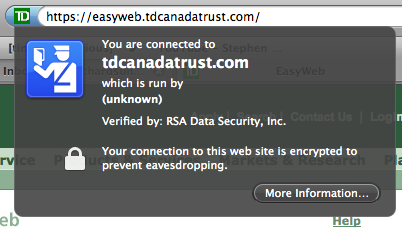May 11, 2008
Phishing faceoff - Firefox 3 v. the market for your account

Dria writes up a fine intro to the new Firefox security UI, the thing that forms the front line for phishing protection.
Basically, the padlock has been replaced with a button that shows a "passport" icon in multiple colours and with explanatory text. Pretty good, although as far as I can see, this means you can no longer *look* and tell what is going on. OK, I'll run with that as an experiment! For now, there are 4 colours: grey, blue, green and yellow. Grey is for no identity, and I guess that also means no TLS although it isn't that clear as encryption edge-cases are not shown. Blue is Good, being the conventional browser security level, and Green is the EV colour for their new enhanced "better than before" identity verification.
One minus: yellow is now a confusing colour. Before it was the colour of success, now it is the colour of failure (although that failure is easily rectified by clicking to add an exception). As I commented before, we do need the colours to be re-aligned after a period of experimentation. Kudos to Firefox team for taking that one on the chin, if only others were prepared to clearly unwind some well-meaning ideas...

Second Minus: As many said in comments, the "invalid identity verification" isn't always that, sometimes it is a non-third-party verification. This needs to be distinguished between "identity not 3rd-party verified" and "self-verified."
Indeed, our old friend, the self-identified or self-signed certificate, is widely used in technical community for local and small scale security systems, so we can see the message "not trusted" and "invalid" are simply wrong. Now, Jonath says that Firefox is planning to do Key Continuity Management, so it may be that the confusing messages get cleaned up then. (I don't know if anyone else has spotted the nexus, but when we take KCM and combine it with 3rd party verifications, sometimes called variously TTP or CVP or certificate authorities, then we get the best of both worlds. It will eventually come, because it is so sensible.)
One Good Plus: the CA is displayed in all cases where the certificate information is available. This is exceedingly important because it is the CA that does the verification of identity; Firefox only repeats it (which is why the "trusted" message is soooo wrong). Slowly but surely, we have to move the browser UI to pin the assertation on the CA, and we have to move the user to thinking about CAs as competing, branded entities that stand behind their statements. Publically. At least, Firefox has not made the mistake that Microsoft has made with the new IE, which displays the name of the authority in some circumstances, but not others.
It is important to realise: we can take a few missteps along the way, such as Gerv's noble attempt with the colour yellow. It is very costly to get these UIs built, trialled and tuned, so any experiments have to be taken with an expectation of more improvement in the future. As long as we're moving forward, things are getting better.
What's all this about? Why is it important? Pop over to Francois' post on stolen accounts to see the real reason:

(Hat tip to Gunnar again.) Them's hard numbers! A quick eyeball calculation over Francois's numbers reveals that the going price of a well-funded account is 8% of the value. This makes some sense, because getting access to the account details is easy, it's done in bulk, given that the security systems of online banks are so fundamentally and hopelessly flawed. What is more difficult is getting the money out, because, since the arisal of phishing, and the sticking of some of the liability, occasionally, to the banks, the online security teams have done some things to make it a little trickier. So the lion's share goes to the money launderer, who needs to pay a lot more in direct costs to get his hard-stolen loot out.
How does this relate to Firefox? Phishing arose as an attack on the browser's security UI, so the Firefox team are working to address that issue with KCM, better displays of the CA name that makes the claim, and more clear symbols. The first 2 images above may help you to avoid the 3rd image.
Unfortunately, the big picture overtook the browser world, so the work is only just starting. Phishing caused massive funds to flow into the attackers, so they invest in any attacks that might return more value. Especially, the attack profile now includes MITM and trojans, so hardening of the browser against inside attacks will be increasingly necessary.
Remember, the threat is on the node, not on the wire; which gives us an answer to the question that Jonath was posing: Hardening against inside attacks should be on the agenda for future Firefox.
Posted by iang at May 11, 2008 12:44 PM | TrackBack